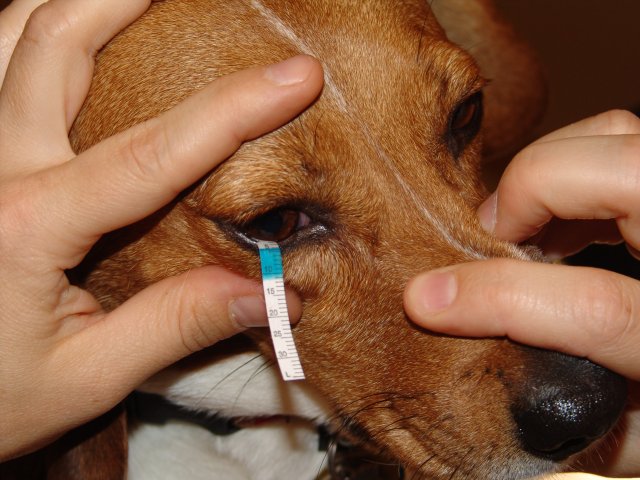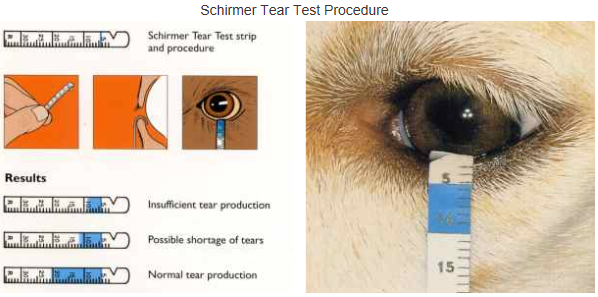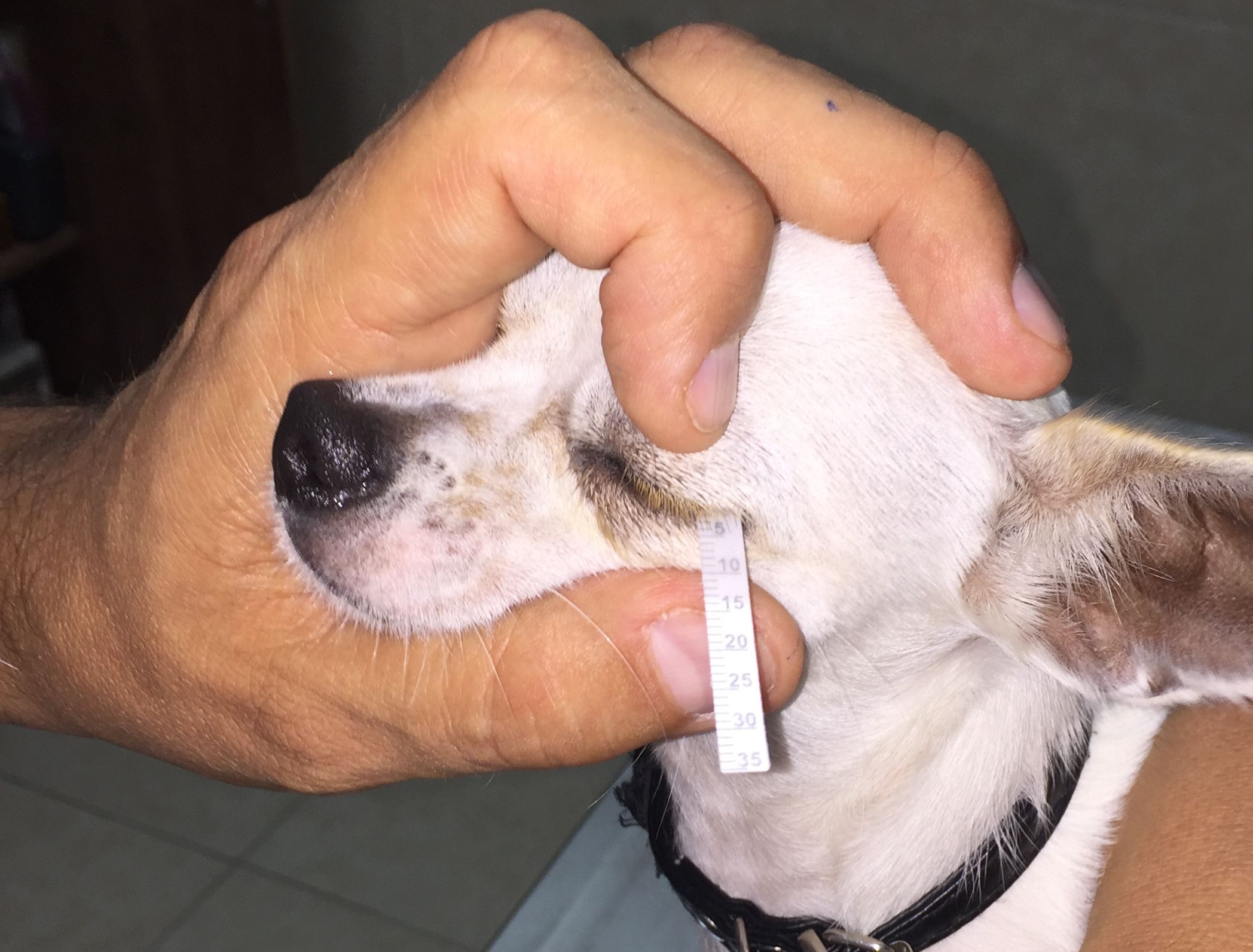normal stt dog
Dazu wird das Ende des Teststreifens in das untere Augenlid. The mean SD STT I value was 156 37 mmmin range 10-22 mmmin while the mean STT II value was 124 38 mmminute range 5-18 mmmin.

Dry Eye In Dogs King S Ridge Veterinary Clinic
Dry eye can easily be overlooked.

. It is a common component of eye examinations in animals. A dog is diagnosed with dry eye if the stain on the test strip only reaches 10 mm or less. The normal rate of canine lacrimation established by Schirmer tear testing is in the range of 1864 - 447 mmmin to 2390 - 573 mmmin.
For example animals that have 10 mmmin in the absence of clinical signs may not need. The veterinarian places the tip of the filter paper inside the eyelid closes the eye and holds the paper there for exactly 60 seconds. For example tear osmolarities of normal dogs were 3374.
Always do a STT schirmer tear test in all cases of ocular discharge conjunctivitis and corneal disease. Except for STT-1 with a normal range of 15 mmmin in dogs the reference ranges for DETs to evaluate canine KCS have not yet been established 11. When the patients were divided into two groups according to their STT values at the beginning of treatment.
No significant difference was found between males 14750 mmmin and females 15145. The test strip has a printed ruler on one side with a scale divided into millimeters. The Schirmer tear test is a simple way.
Normal production in dogs is 15 mmmin. A test strip of a dog with normal tear production will stain the test strip up to at least the 15mm mark. A normal STT-1 value is 15 mm of wetting after one minute for both dogs and cats.
The Schirmer tear test STT can help determine if low tear production is an underlying cause or a contributing factor to an dogs eye problem. Low tear production can cause significant eye inflammation and chronic eye problems. The most frequent LLT range measured by IF was 3080 nm 11 eyes followed by 80 nm 5 eyes and 80140 nm 4 eyes.
MGLRU 25 was measured in 11 eyes and 2650 in 9 eyes. Maximum 005 sec in small breeds. Bei Verdacht auf KCS sollte zur Abklärung immer der Schirmer-Tränen-Test STT durchgeführt werden.
Management Images Management of Dry eye Artificial Tears There are many brands on the market and in most cases it does not matter what type you use. KCS in a Lhasa apso dog STT reading in mmminute Interpretation Action required 0-10 Insuffi cient tear production Treatment is required 10-15 Lower than normal Treatment may be required monitoring is important 15-25 Normal --25 Normal or excessive Occasionally needs investigation. 005 sec in giant breeds Height.
Mean values for STT-1 TMH and NIBUT were as follows. Performing an STT involves placing the tip of a small thin strip of special filter paper inside the lower eyelid. Tear production is maximal in dark periods and minimal in light periods.
But when considering the STT results you must consider several factors. It has recently been determined that these adult values are not attained until 9-10 weeks of age. The mean STT for dogs showing normal ferning patterns was 206mmmin for the left eye and 213mmmin for the right eye.
A respiratory rate is how many times a dog takes a breath in a minute and is recorded as Breaths Per Minute BPM. Need to correlate results with clinical signs and test suspicious animals frequently to monitor for trends. STT values between 6 to 10 mmmim and group 2.
Severe dry eye is diagnosed when the measurement reaches 5 mm or less. In other studies on DETs the results in dogs and human differed. 217 34 mmmin 041 021 mm and 191 95 sec respectively.
STT values 6 mmmin the response to treatment was better in group 1 936 than in group 2 805. There was a significant difference between STT values in kittens 6 months old and cats of other age groups P. Some animals with deficiencies in the two other portions of the tear film lipid and mucin may have normal STT but may still benefit from tear replacement therapy.
Animal gender did not have a significant effect on STT I and II values P 052. Other research indicates that tear production may vary with a circadian rhythm. As a general rule of thumb normal STT values should be 15-25 mmminute.
A Schirmer tear test 1 STT1performed without application of surface anesthetic agentsassesses reflex tear production. Some normal animals may have a low STT. 1 cm 1 mV Dog P wave P-R interval QRS complex S-T segment Width.
006 to 013 sec Width. Some particular responses were seen in these dogs. MGLRL 25 in 8 eyes and 2650 in 12 eyes.
The filter paper is specially formulated to absorb tears. A substantial number of cats with clinically normal eyes had STT values less than 10 mmmin. A lower STT-1 value in a dog is consistent with KCS when correlated with clinical signs.
Normal STT values were obtained after treatment in 319 patients 855. A mean STT 14948 mmmin was calculated for the eyes of all cats. Dieser besteht aus einem speziellen Teststreifen der die Menge der Tränenflüssigkeit im Auge misst.
The normal STT for a dog should be 15 mm wettingminute. It has been suggested that 11-14 mmmin is suggestive of early KCS while 6-10 mmmin is moderate KCS and less than 5 mmminute is severe KCS. In my opinion these values have to be interpreted in light of other clinical signs.
Low STT-1 values are common in cats with noninflamed and otherwise normal eyes though the published normal values are similar to that of dogs. Dog Normal sinus rhythm Sinus arrhythmia Wandering sinoatrial pacemaker Cat Normal sinus rhythm Sinus tachycardia physiologic reaction to excitement Measurements lead II 50 mmsec. Most sources state that the reference range of Schirmer tear test STT values is 15 to 20 mmmin in most species.
A Schirmer tear test is indicated anytime a dog has a reddened eye or has thick discharge from the eye. First older dogs frequently have STT values lower than 15 mmmin but have no clinical signs of keratoconjunctivitis sicca KCS. In our study the STT showed a meanSD value of 20932Table-1 with a mmmin median of 21 mmmin in both eyes normal range 146273 mmmin showing no significant differ- ence between eyes.
No significant differences in the mean values of STT. This action is necessary to bring oxygen into the body and expel carbon dioxide simply called breathing. Maximum 04 mV Width.
The mean STT II value was significantly lower than the STT I level P 0001. Clinical Signs of Quantitative KCS Thick adherent mucopurulent discharge Figure 1 Conjunctivitis Blepharospasm Dry lusterless corneal appearance. 2 An inhale and exhale together counts as one breath.
STT values for eyes with abnormal ferning patterns were 109mmmin and 124mmmin these differing from the normal eyes with STT above 15mmmin significantly. Study sets textbooks questions. These findings suggest that tear ferning could be a valuable technique for assessment of the tear film in.
If the color on the test strip reaches 10 to 14mm the result is considered borderline.

Scielo Brasil Comparison Of Strip Meniscometry And Schirmer Tear Test Results And Tear Film Breakup Time Between Healthy Dogs And Dogs With Dry Eye Disease Comparison Of Strip Meniscometry And

Mean And Standard Deviation Of The Schirmer Tear Test 1 Stt 1 Values Download Scientific Diagram
Schirmer Tear And Fluorescein Tests Hellenic Journal Of Companion Animal Medicine
Schirmer Tear And Fluorescein Tests Hellenic Journal Of Companion Animal Medicine
Tear Film Deficiencies Quality Vs Quantity Vetbloom Blog

Schirmer Tear Test Stt Results At Baseline Day 1 T 1 Day 3 T 3 Download Scientific Diagram

Dry Eye In Dogs When Good Glands Go Bad Clinician S Brief

옵티뮨 Kcs 만성건성각결막염 Stt 옵티쉴드 옵티케어 일산동물약국 네이버 블로그

2 Simple Tests For Assessing Ophthalmic Health Clinician S Brief

Neurogenic Keratoconjunctivitis Sicca In 34 Dogs A Case Series Galley 2022 Veterinary Ophthalmology Wiley Online Library

Pdf Tear Ferning In Normal Dogs And Dogs With Keratoconjunctivitis Sicca Semantic Scholar

Strip Showing Normal Reference Value Of Tear Figure 1 Position Of Strip Download Scientific Diagram

2 Simple Tests For Assessing Ophthalmic Health Clinician S Brief

Diagnosis And Treatment Of Dry Eye In Dogs

Canine Keratoconjunctivitis Sicca An Overview Semantic Scholar


Comments
Post a Comment